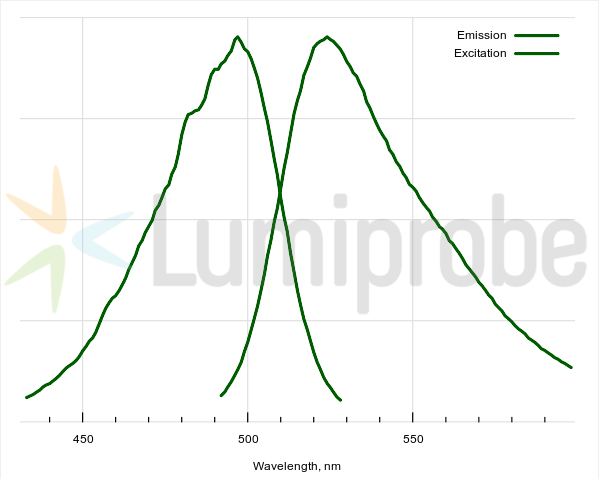dsGreen® for Real-Time PCR, 100×
| Cat. # | Quantity | Price | Lead time | Buy this product |
|---|---|---|---|---|
| A1010 | 50 uL |
–
|
in stock | |
| 11010 | 100 uL |
$39
|
in stock | |
| 41010 | 1 mL |
$235
|
in stock | |
| 71010 | 5 mL |
$510
|
in stock | |
| 91010 | 50 mL |
$2670
|
in stock |

dsGreen® is a very sensitive dsDNA detection dye. High sensitivity, and high selectivity for dsDNA allow to use dsGreen as a universal dsDNA detection reagent for qPCR. No need to use labeled probes to detect amplification with dsGreen – unlabeled primers are sufficient.
Unlike other preparations of dsGreen provided by Lumiprobe for gel staining purposes, this formulation is specially designed to be used in real-time PCR experiments. Specific features are:
- Concentration of the dye is optimized for qPCR and carefully adjusted for reproducible results from lot to lot
- PCR tested preparation – quality guaranteed
- Low fluorescence background – high fluorescence intensity gain
Excitation and emission spectra of dsDNA complex with dsGreen

Recommended protocol
Calculator
Help center
Customers also purchased with this product
General properties
| Appearance: | light orange solution |
| Quality control: | NMR 1H, HPLC-MS (95%), PCR testing |
| Storage conditions: | Storage: 24 months after receival at -20°C in the dark. Transportation: at room temperature for up to 3 weeks. Avoid prolonged exposure to light. |
| MSDS: | Download |
| Product specifications |
Spectral properties
| Excitation/absorption maximum, nm: | 490 |
| ε, L⋅mol−1⋅cm−1: | 73000 |
| Emission maximum, nm: | 524 |
| Fluorescence quantum yield: | 0,8 |
Product citations
- Huber, R.; Lee, J.; Borretta, L.; Tessier-Cloutier, B.; Lum, A.; Yip, S.; Horst, B.A. TERT promoter mutations in atypical melanocytic lesions: A series of seven cases with adverse melanoma-specific outcome. Human pathology, 2024, 144, 34-39. doi: 10.1016/j.humpath.2024.01.003
- Mazunina, E.P.; Gushchin, V.A.; Kleymenov, D.A.; Siniavin, A.E.; Burtseva, E.I.; Shmarov, M.M.; Mukasheva, E.A.; Bykonia, E.N.; Kozlova, S.R.; Evgrafova, E.A.; Zolotar, A.N.; Shidlovskaya, E.V.; Kirillova, E.S.; Krepkaia, A.S.; Usachev, E.V.; Kuznetsova, N.A.; Ivanov, I.A.; Dmitriev, S.E.; Ivanov, R.A.; Logunov, D.Y.; Gintsburg, A.L. Trivalent mRNA vaccine-candidate against seasonal flu with cross-specific humoral immune response. Frontiers in Immunology, 2024, 15, 1381508. doi: 10.3389/fimmu.2024.1381508
- Koryukov, M.A.; Oscorbin, I.P.; Novikova, L.M.; Gordukova, M.A.; Turina, I.E.; Galeeva, E.V.; Kudlay, D.A.; Filipenko, M.L. A Novel Multiplex LAMP Assay for the Detection of Respiratory Human Adenoviruses. International Journal of Molecular Sciences, 2024, 25(13), 7215. doi: 10.3390/ijms25137215
- Shkodenko, L.A.; Mohamed, A.-A.; Ateiah, M.; Rubel, M.S.; Koshel, E.I. A DAMP-Based Assay for Rapid and Affordable Diagnosis of Bacterial Meningitis Agents: Haemophilus influenzae , Neisseria meningitidis , and Streptococcus pneumoniae. International Journal of Molecular Sciences, 2024, 25(15), 8282. doi: 10.3390/ijms25158282
This Product is offered and sold for research purposes only. It has not been tested for safety and efficacy in food, drug, medical device, cosmetic, commercial or any other use. Supply does not express or imply authorization to use for any other purpose, including, without limitation, in vitro diagnostic purposes, in the manufacture of food or pharmaceutical products, in medical devices or in cosmetic products.
Short link - lumiprobe.com/sh/p/5
The count of items is incorrect.























 $
$ 
